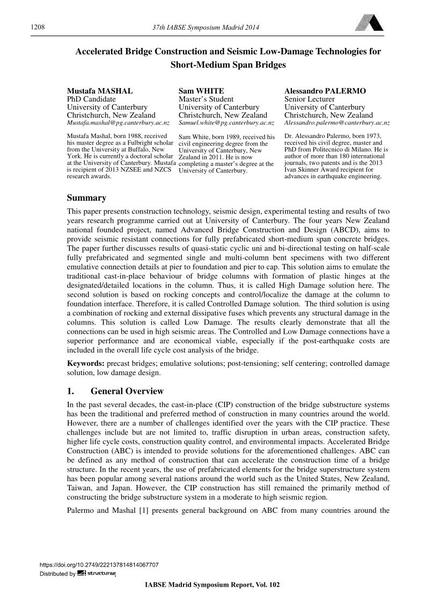Accelerated Bridge Construction and Seismic Low-Damage Technologies for Short-Medium Span Bridges

|
|
|||||||||||
Bibliographic Details
| Author(s): |
Mustafa Mashal
Sam White Alessandro Palermo |
||||
|---|---|---|---|---|---|
| Medium: | conference paper | ||||
| Language(s): | English | ||||
| Conference: | IABSE Symposium: Engineering for Progress, Nature and People, Madrid, Spain, 3-5 September 2014 | ||||
| Published in: | IABSE Symposium Madrid 2014 | ||||
|
|||||
| Page(s): | 1208-1215 | ||||
| Total no. of pages: | 8 | ||||
| Year: | 2014 | ||||
| DOI: | 10.2749/222137814814067707 | ||||
| Abstract: |
This paper presents construction technology, seismic design, experimental testing and results of two years research programme carried out at University of Canterbury. The four years New Zealand national founded project, named Advanced Bridge Construction and Design (ABCD), aims to provide seismic resistant connections for fully prefabricated short-medium span concrete bridges. The paper further discusses results of quasi-static cyclic uni and bi-directional testing on half-scale fully prefabricated and segmented single and multi-column bent specimens with two different emulative connection details at pier to foundation and pier to cap. This solution aims to emulate the traditional cast-in-place behaviour of bridge columns with formation of plastic hinges at the designated/detailed locations in the column. Thus, it is called High Damage solution here. The second solution is based on rocking concepts and control/localize the damage at the column to foundation interface. Therefore, it is called Controlled Damage solution. The third solution is using a combination of rocking and external dissipative fuses which prevents any structural damage in the columns. This solution is called Low Damage. The results clearly demonstrate that all the connections can be used in high seismic areas. The Controlled and Low Damage connections have a superior performance and are economical viable, especially if the post-earthquake costs are included in the overall life cycle cost analysis of the bridge. |
||||
| Keywords: |
post-tensioning low damage design precast bridges emulative solutions self-centering controlled damage solution
|
||||
